ECC802S TELEFUNKEN
This a about a TERRIBLE and really disgusting way to FAKE the extremely expensive TELEFUNKEN ECC802S
Some information about ECC82, ECC802S, 6211
ECC802S is a High Quality tube by Telefunken. The generic part number is ECC82, which is a commercial tube, with electrical data somewhat comparable to 6SN7.
First, a small information about the right type of tube to use. Really some electronics designers think they can create 'better' design just by doing things 'different'. But when I see this develop into a discussion about design problems vs. tube problems, it becomes a waste of time. Most problems result from choosing tubes for an application which they were not intended for. It results from doing things different. People see a particular tube (optically) and want to use it in a circuit, without reading the text part of the data sheet, writing what the tube is intended for. Then we see driver tubes ending up in a phono stage, or switching tubes (like 6211) used as audio tubes. Some years ago, 6211 was on Ebay in boxes of 100pcs.
Of course we take it for granted when small signal tubes are less microphonic. Yet accepting the other side of this story is generally a problem. So people simply use tubes intended for large signal, into a pre amplifier, or even a phono stage, only to find out these tubes have noise or microphonics, which they call a tube issue. Not understanding they have an amplifier issue. They feel justified, because they notice there are brand differences, or date code differences. Or swapping a noisy tube from the one channel to the other, also proves the 'poblem follows the tube'. The expert professors then divide the tubes in such which are bad and good. They think they did great research, and want to tell everybody about it. Then, when explaine, the real problem is their wrong use of the tubes, they say this a just silly excuse for tube quality issues. They are completely blocked by this, end really think a high signal tube has to work well in a low noise circuit.
Another such a problem can result from taking tubes which are intended for small signal, and use them as a driver tube. Small signal tubes are by nature high gain. However high gain tubes, have a higher output impedance than low gain tubes. That is just physics. The higher gain is always coming at the cost of some other properties. Only with clear understanding of the intended use of the tubes, problems can be avoided. In general, when using tubes not as intended, it is asking for trouble.
In this context we have to place the ECC82. This is by nature a general purpose tube, of the kind 'What goes in, is what comes out'. It has reasonable low output impedance, but not extremely low. It has reasonable gain, and tube curves are good as long as you stay in the intended range. However, to get that all of that, there is a drawback. It needs high anode current. And that means lower lifetime. It's predecessor, 6SN7 had larger glass, allowing wider anodes, and octal is wider socket too. 6SN7 worked electrically almost the same, but it can get rid of the internal heat more easily, which is very beneficially for life time. The much greater heat of the ECC82 anodes, compromises the lifetime.
In this light we have to look at the SQ tubes, the five star tubes, or 6189WA, and from Telefunken and TESLA the ECC802S. So here we have the issue of the intended use again. These Special Quality tubes are intended for the things they are intended FOR, and you need to read that in their data sheets, what exactly these things are. Data sheets are really very clear about what the tube is made for.
Now comes ECC802S. What do we read in the datasheet? Well many, very many things are written there. Many of those, will not be mentioned in the ECC82 datasheet. Indirectly, this also describes where ECC82 has it's weakness. Like when ECC802S has a specified maximum unbalance between to systems, it means ECC82 has larger unbalance, of which they do not even say this is so. ECC802S has published tests for incoming inspection. Also end of life is specified. WIth ECC82 you don't have those numbers, so you have no clear way to test them. Just from reading the ECC82 data sheet only, you would not even be aware what is missing.
The same is for Sylvania 12AU7 vs. Sylvania 6198WA. Things which are better with the 6198WA, the standard 12AU7 does not have that. So when 6189WA is a minimum 10.000 hours tubes, it means 12AU7 has less hours than that. I really encourage you to compare those two data sheets, it is very helpful to see how data sheets are set up, how you should read them.
We stay with ECC802S for now. I think for audio, the main goodies are 'Long Life' 10.000 hours, plate current of System 1 and System 2 is balanced, and many min-max windows are specified. And...it is low noise. This does not mean a random ECC802S has always less noise than a random ECC82. Just ECC802S has guaranteed numbers. So any rejects were destroyed. Unlike ECC82 where a higher noise batch is not necessarily rejected.
The list of published improvements is the largest with Telefunken, and 6189WA (though a very high grade tube) does not match this exclusive Telefunken data sheet. This explains the popularity of the ECC802S
How was this achieved? The longer lifetime results from larger anodes, which reduces the temperature. Also TFK uses a special cathode coating. In the end, tighter specifications result from smaller manufacturing tolerance (such as anode distance), longer burn in, and of course testing more parameters, and doing so more critical. The latter is called 'uptesting'.
We have to say it, ECC802S is the finest ECC82 ever made, but unfortunately the market was small for such an expensive tube, and production was always low. There are simply not many around, and for a good pair, prices around 1000 Euro are asked easily (price of 2024).
TELEFUNKEN ECC802S vs. 6211
There is another dedicated tube which is the 6211 switching tube. This tube is not dedicated at all for audio purposes. Tube curves show more distortion. Switching tubes are really intended for on/off situations. So high output current, such as a relay needs, combined with high transconductance and high gain. How is that magic possible? Well very simple: There is no magic. There is always some compromise, and with 6211 the linearity is terrible. Yet, when looking at the curves, they are not so very terrible if you work at low voltage. However at 250V or 350V as you can we are used to with HiFi, there is more distortion.
Telefunken inspired their 6211 on the ECC802S, the difference I can see by looking inside, they used a grid with half the wire distance, and also increased the anode distance. This makes it a totally different tube, with twice the transconductance, and twice the gain of ECC802S.
Yet in several auto bias circuits, the tube appears to work, though plate current will be only 60%. Only, it works not very good, because high signal will come at the cost of too much distortion.
It should be clear, the FAKING MAFIA will re brand the TFK 6211 as ECC802S, and end users have only small chance to find it out. However, today's mobile phone cameras are now so good, you can use them as a magnification tool.
How to recognize fake ECC802S made from 6211.
1) Anode current.
At fixed grid voltage, they test like 'just ok' ECC802S. So a bit low on anode current. However if a tube is week on emission, just go to 10% over heating, and they would become a lot better. Doing so with 6211 will give no change. This is proof the 6211 is at least not poor in emission, and then it is also proof, the problem is somewhere else.
2) Transconductance.
This is very confusing, and Gm will be 'excellent' when you use non-numeric testers like TV7. Moreover you would use bias for 12AU7 of course, but that will reduce plate current, and consequently reduce Gm too. So the tube will test with lower plate current, and 'excellent' Gm.
When you use testers with real parametric testing, you should adjust the plate current to values which are normal for ECC802S. LIke 10.5mA. Now, Gm is 6000 instead of 2000 for ECC802S. Such a CRAZY difference.
3) Gain
Few testers can do this, but if you can you will find gain is 40x instead of 20x.
4) Visual inspection.
This text here applies for TELEFUNKEN only.
You can see the grid through the little inspection holes in the anode. The grid of real ECC802S will show 3 grid wires. The grid of 6211 will show 6...7 very fine grid wires.
Here are some pictures I made of fake ECC802S with a low cost mobile phone. ( I used an Iphone 5c)
I bought these from a tube company in Germany. I can not write his name here of course.
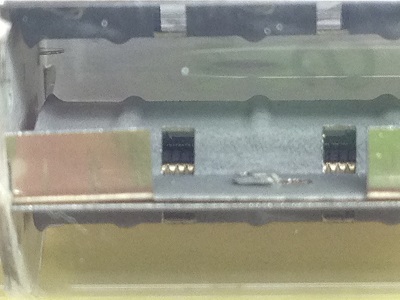 .
. Original Telefunken ECC802S, showing three grid wires through the inspection holes.
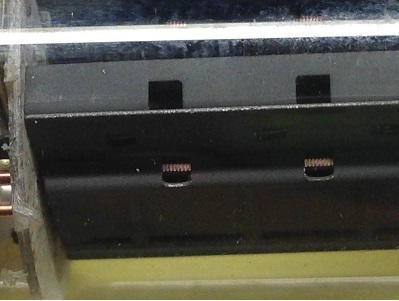 .
.
Faked Telefunken ECC802S (re branded Telefunken 6211), showing seven grid wires through the inspection holes.
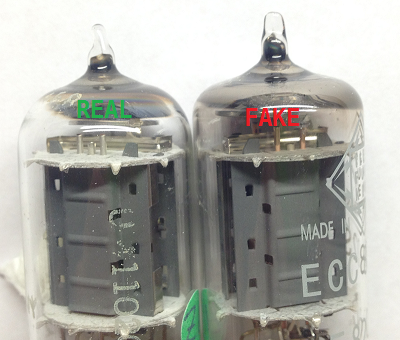 .
.
Faked Telefunken ECC802S (re branded Telefunken 6211). On the right is the fake you can see the grid is copper color. With the ECC802S in the left, the grid is white color.
CAREFUL: This grid bar color may NOT have to say very much. You should not use it to determine a fake, because I have seen also (real) 6211 with white grid bars. It is at least something to keep an eye on. What really counts is the grid wire distance as in the previous pictures.
5) The data code. Fakes have typical always the same date code. With originals when buying RARE tubes (and ECC802S certainly is) you can call yourself very lucky when two date codes are the same. But with fakes, often they all have the same date code.
Moreover the date code originally is printed vertical as a SEPARATE printing. Just imagine a production environment. Logically, the date code. stamp is made by it's own tool, with a date clock in it. Perhaps even stamped by hand, and print quality can be lower, so we talk about a tool here. Not about a special logo stamp. Whereas Telefunken brand logo is stamped with a very high quality tool, which gets made and then used for many tubes. That can never include a date code of course. .
With the fakes, you often can see, date code is part of the total printing, done at once.
7) Plate distance. Not only 6211 has another grid, also the plate distance is wider. I did not want to break the tube glass, just to see that, but I would estimate with ECC802S it is a little below 3mm, and with 6211 it 4.5mm. A bit difficult to see when looking at only one tube, but very easy in direct compare.
Increasing plate distance will increase the gain because there is now less anode field feedback to the grid field. Also this generally stretches the vertical axis and compresses the horizontal axis of the tube curves.
8) The individual number. This is the small printing on the TOP of which I do not fully know it's function. These 3-digit numbers seemed randomly, on the 10 tubes I received.
CALL FOR HELP: If somebody knows more about these numbers, please let me know!
9) The boxes. This is saying something, but not too much. It is just paper.
10) The tube curves.
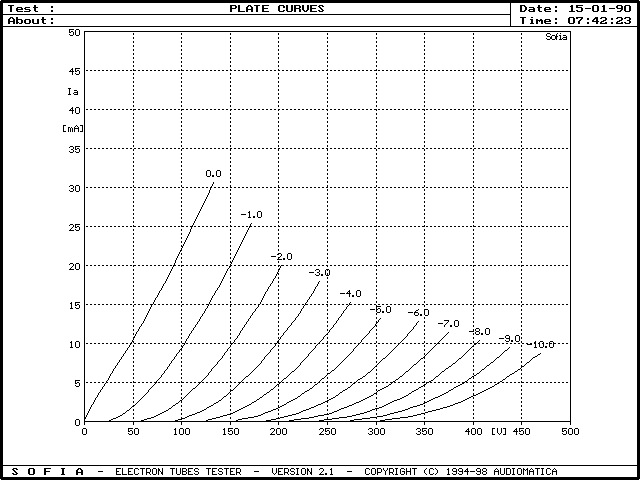
This is from the faked ECC802S.
Please note, the date of my Sofia tester, can not be set higher than the year 2000, so I set it for 1990.
I made the curves myself, with my SOFIA Tester, using some pairs of FAKED ECC802S, I bought from a German tube company. It is clearly visible from the curves, these are 6211. It was no problem to give them back, but I can tell you when you only use a parametric tester, like the AT1000, or every other tube tester, and set it for ECC82, these tubes will test 'good'. It went like this: The first tube was 'just ok'. Well it can happen. The second tube was 'just ok'. Well, bad luck. And the third tube, and the fourth... etc. So I just made the tube curves, to see if there is some general problem with the emission. But the emission was good. Only.... what weird curves, totally unlinear. It took me quite some time, to realize I was fooled, because I never heard of this faking method. Then when I compared the curves with 6211, it was a hit. Yes, these are 6211, they rubbed off the 6211, and printed ECC802S on it.
The strange shape of the 0V curve is typical, and of course the bias point at 250V 10.5mA is totally wrong.
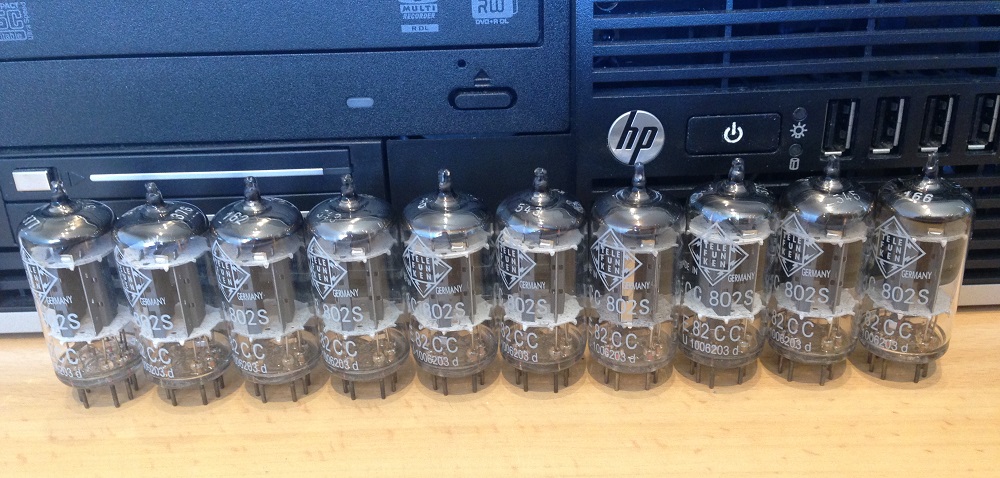
These are the faked tubes in front of my test computer. These are 6211, not ECC802S.
Date code: U1006203 d